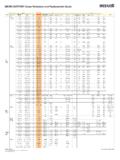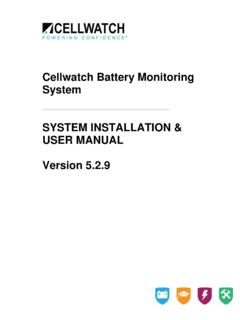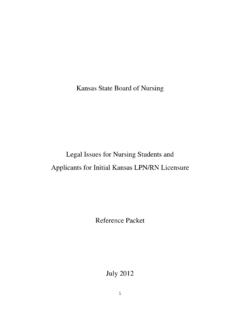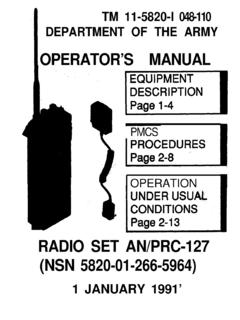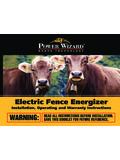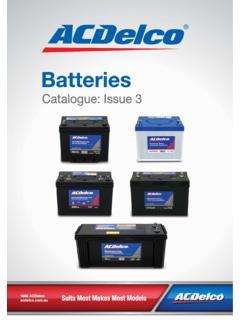Transcription of A solar-powered buck/boost battery charger - TI.com
1 Analog Applications JournalHigh-Performance Analog Products 2Q 2012 texas instruments Incorporated8A solar - powered buck / boost battery chargerIntroductionCharging batteries with solar power has become very popular. A solar cell s typical voltage is V. Panels range from having one cell to several cells in series and are therefore capable of producing a wide range of voltages. Most battery chargers on the market today step down, or buck , their input voltages. Therefore, to charge a two-cell lithium-ion (Li-Ion) battery , for example, a solar panel capable of producing at least V is needed. However, this same charger cannot be used to step up, or boost , its input voltage to charge a multicell Li-Ion battery used in a laptop or a 12-V lead-acid battery used in a solar lantern. It is possible to mod-ify a buck battery charger into a battery charger that both bucks and boosts. This article identifies the key concerns of chang-ing a buck battery charger into a buck / boost SEPIC charger and provides a design exam-ple using the texas instruments bq24650 battery charger controller for solar power stage versus buck power stageFigure 1 shows a simplified block diagram of a battery charger controller.
2 The charger controller IC monitors the charging current through RSNS and the battery voltage through the feedback resistors (RTFB and RBFB) and adjusts the output of the power stage to meet the charging parameters. If the input source voltage can be both higher and lower than the maximum battery voltage, a SEPIC power stage capable of bucking and boosting can be 2 compares a synchronous buck power stage and a nonsynchronous SEPIC power stage. The buck controller s high-side gate drive (GDRVHI) is used to drive the SEPIC converter s power FET (QPWR). However, a buck controller cannot be easily configured to drive a synchronous rectifying switch for a SEPIC converter. Therefore, QSYNC is replaced by diode DRECT, and the low-side gate drive is not used. A buck con-verter also provides continuous inductor current, filtered by the capacitors CO_BUCK and CO_CHRGR, to the load, regardless of which switch is on. Unlike the buck converter, the SEPIC converter uses QPWR only to charge the induc-tor.
3 During this time the output capacitor must supply the battery -charging current. When DRECT turns on, the now charged inductor provides both the output capacitor recharging and battery -charging currents. Hence, the SEPIC converter s output-voltage ripple will always be By Jeff Falin, Factory Applications Engineer,and Wang Li, Factory Applications EngineerPower ManagementVINCO_CHRGRS olar-PanelInputSupplyPowerStageBuckCharg erControllerGDRVHIGDRVLOVRSNS+VRSNS VREFFBVCCCFLTRRSNSVBAT+RTFBRBFBF igure 1. Block diagram of battery charger controllerVINVO_BUCKCO_BUCKQSYNCGDRVHICI NLQPWRGDRVLOVINVO_SEPICCO_SEPICQPWRCMIDD RECTGDRVHICINL1L2 Figure 2. buck power stage (top) versus SEPIC power stage (bottom) texas instruments Incorporated9 Analog Applications Journal2Q 2012 High-Performance Analog ProductsPower Managementhigher than that of a buck converter with the same induc-tor and output capacitance and same output power. This ripple can cause inaccurate current measurement across the current-sense resistor.
4 As shown in Figure 1, a SEPIC charger requires a larger filtering capacitor (CFLTR) and larger output capacitors (CO_SEPIC and CO_CHRGR) than does a buck precharge current when VBAT << VBAT(LOW)With a deeply discharged battery , the battery voltage is below a predetermined VBAT(LOW) threshold. For battery safety, the charger should not provide full charge current to the battery . Therefore, a current-limiting resistor between the charger and battery is recommended to limit the charge current to a lower, precharging current value. Once the battery voltage exceeds the selected VBAT(LOW), this resis-tor can be shorted out with a FET to allow the controller to provide higher charge currents. Figure 3 shows how resistor RPRECHRG, a FET (QSHRT), and a comparator can be used to implement this is sized so that the voltage drop from IPRECHRG flowing through RPRECHRG, plus the deeply discharged bat-tery voltage (VBAT(LOW)), is higher than the charger s low- battery threshold (for example, VLOWV), typically sensed by the VFB pin.
5 QSHRT is sized to accommodate the max i-mum battery voltage (VBAT(MAX)) and the maximum charge current (ICHRG(MAX)). The resistor across the comparator (RHYS) provides hysteresis. Therefore, resistor dividers are needed on the sensed voltages fed to the operation when VBAT > VIN or when VBAT < VTH(BATSHORT)A buck charger expects the battery voltage to always be less than its input voltage. In fact, many chargers have a feature that puts the charger into sleep mode if VBAT is greater than VIN. Alternatively, if VBAT falls below a certain threshold, the IC may assume the battery is shorted and enter protection mode. If the current-sense pins (VRSNS+ and VRSNS ) are used to determine the battery s state, the sensed voltages need to be level shifted. Figure 4 shows how to use an instrumenta-tion amplifier configured as a current-shunt monitor to level shift the current information sensed across RSNS. This circuit keeps the DC set point of the sensed voltages low enough that the IC does not enter sleep mode; it also keeps the voltages high enough so that the IC does not enter short-circuit protection.
6 If the charger does not have its own reference voltage (VREF), an external reference IC can be + +Figure 3. Precharge circuitry+ VO_SEPICVO_CHRGRCO_SEPICVRSNS+VRSNS CFLTR2 CFLTR1 RSNSVO_CHRGRCO_CHRGRVINVBIASC urrent-ShuntMonitorFigure 4. Current-sense level-shift circuitTexas instruments Incorporated10 Analog Applications JournalHigh-Performance Analog Products 2Q 2012 Power ManagementComputing the maximum charge currentA SEPIC converter s maximum charge current is a function of its available input power, both voltage and current. A simple way to estimate the maximum charge current is to compute a power balance where POUT/PIN = hEST, where hEST is an estimate of the boost charger s efficiency in sim-ilar operating conditions. The following equation can be used to estimate the maximum charge current at a specific battery voltage:IN(MPP)IN(MPP)ESTCHRG(MAX)BATVII ,V =where VIN(MPP) is the solar panel s maximum power-point voltage, and IIN(MPP) is the solar panel s maximum power-point should be sized to provide ICHRG(MAX).
7 Because capacitor CMID between the inductors stays charged to the input voltage, QPWR must have a voltage rating slightly higher than VIN(MAX) + VBAT(MAX). In a SEPIC converter, L1 s peak current is the maximum input current (IIN(MPP)) plus half the ripple current (DIL/2), and the peak current of L2 and diode DRECT is the maximum output current (ICHRG(MAX)) plus DIL/2. QPWR sees the sum of these peak currents when it is on, so it must have a current rating higher than IIN(MPP) + ICHRG(MAX) + DIL. The bq24650 charger controller can adjust the charge current to keep the solar -panel output at its maximum power example of a solar -charged batteryTable 1 maps the functional pin names from Figure 1 to the corresponding bq24650 pin names in Figure 5. Figure 5 shows the charge controller configured to charge a two-cell Li-Ion battery with a maximum charge voltage of V. The maximum charge current was limited to A. The power NFET (Q2) and rectifying diode (D1) were sized using standard design guidelines for a SEPIC converter.
8 The inductor and the output capacitors (C3 and C4) were sized to reduce inductor-current ripple and the resulting output-voltage ripple as well as to improve the small-signal control-loop phase margin. A coupled inductor, in the same footprint but only slightly taller than its single-inductor counterpart, was used instead of two separate inductors. The coupling effect allows the use of half the inductance that would have been necessary for the same current ripple Table 1. Cross-reference for controller pin namesFIGURE 1 CONTROLLER PIN NAMEbq24650 PIN NAMEGDRVHIHIDRVGDRVLOLODRVVRSNS+SRPVRSNS SRNFBVFBU1bq24650 VCCVREFMPPSETTSTERM_ENSTAT 1 STAT 2 HIDRVPHPGNDBTSTLODRVSRPSRNVFBREGN+ R4D2 BAT54CD1 PDS1040U3 OPA237D3IN4148Q217308Q3 CSDQ2 VINVOVCCVCC++ U4 TLV7211 VOV5 to 19 VIN2-CellBatteryPackVREFVREFVOL1aL1bQ22N 7002R12 R210 R1815 R3301 k R211 k + U2 INA139R171 k R14301 k R11301 k R13750 k R12100 k R2220 m R10100 k R2310 m R20100 to V(Up to 2A) to VBAT(Up to )R1910 M R5301 k R6301 k C71 FR25100 k R24100 k FC81 FC322 FC510 FC422 FC61 FC222 FC71 FFigure 5.
9 The bq24650 configured as a SEPIC chargerTexas instruments Incorporated11 Analog Applications Journal2Q 2012 High-Performance Analog ProductsPower Managementif two separate inductors had been used. R18 was used to slow down the fast turn-on of Q1. Also, the controller s PH pin was grounded to help provide the boosted output voltage. A 10- F filter capacitor (C5) was necessary to reduce switching noise coupled into the current- shunt monitor (U2). To prevent the output of the current-shunt monitor (U2) from loading the SRP pin, a unity-gain buffer (U3), with ground shifted to match that of the current monitor, was necessary. With a discharged bat-tery voltage of V and the bq24650 s VLOWV = V V = V, a minimum pre-charge resistance (RPRECHRG(MIN)) greater V13 A = was needed. A value of 100 W was selected for 6 shows the efficiency of this charger . Although the bq24650 is internally compen-sated for a buck charger , when it is configured as a SEPIC charger its small-signal control loop is stable over a wide operating range, as shown in Figure 7.
10 When using the bq24650 with a different power-stage inductor and different capacitors and batteries, the designer is responsible for confirming loop demand for a buck / boost battery charger is growing, especially as demand for charging from solar panels grows. By following the guidelines presented in this article and using the proposed additional circuitry, the designer can convert a buck charger controller like the bq24650 into a SEPIC charger . When convert-ing a different buck charger into a buck / boost SEPIC charger , the designer is responsible for understanding how that charger operates in order to determine which additional circuitry is necessary and to confirm stable Web partnumber with bq24650, CSD17308Q3, INA139, OPA237, or TLV7211I(A) (%)V= 19 V; V= VINBATV= 5 V; V= VV= V; V= VINBATINBATF igure 6. Efficiency of charger in Figure 550403020100 10 20 30 40 501001 k10 k100 kFrequency(Hz)Gain (dB)1501209060300 30 60 90 120 150 Phase (degrees)19-VGainIN19-VPhaseIN5-VGainIN5 -VPhaseINFigure 7.











